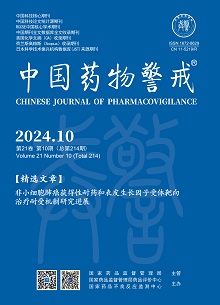|
|
Effect of long-term oral administration of Asari Radix et Rhizoma decoction and its main aristolochic acid analogs to mice main organs
LIU Meiting, MENG Jing, TIAN Jingzhuo, ZHAO Yong, YI Yan, LI Chunying, LIU Chenyue, CUI Shuang, ZHANG Yushi, WANG Lianmei, LIANG Aihua
2024, 21(10):
1087-1094.
DOI: 10.19803/j.1672-8629.20240200
Objective To investigate the toxicological effect of single-dose intragastric administration of Asari Radix et Rhizoma powder and Asari Radix et Rhizoma decoction, and 24-week continuous intragastric administration of Asari Radix et Rhizoma decoction and the equal amount of its major aristolochic acid analogs (AAs) to mice main organs, so as to provide reference for the clinical drug safety application. Methods Acute toxicity experiment: mice were intragastric administrated with Asari Radix et Rhizoma powder (692 times the clinical dose, 11.54 g·kg-1), or Asari Radix et Rhizoma decoction (500 times the clinical dose, 25 g·kg-1; 1 000 times the clinical dose, 50 g·kg-1), then the toxicity to mice were observed within 14 days since administration. Long-term toxicity experiment: Mice were randomly divided into a blank control group, a media control group (0.02% CMC-Na), a positive drug group of aristolochic acid-Ⅰ group (AA-Ⅰ, 27.2 μg·kg-1), an aristolochic acid-Ⅳa group (AA-Ⅳa, 27.2 μg·kg-1), an aristolactam-Ⅰ group (AL-I, 13.5 μg·kg-1), a low-dose group of Asari Radix et Rhizoma decoction (10-time the clinical dose, 0.5 g·kg-1), a middle-dose group of Asari Radix et Rhizoma decoction (31.6-time the clinical dose, 1.6 g·kg-1) and a high-dose group of Asari Radix et Rhizoma decoction (100-time the clinical dose, 5 g·kg-1). Organs were weighed and pathologically examined at 12, 24 weeks and 24 weeks followed by 8 weeks withdraw since drug administration. Results Acute toxicity experiment: All mice died within 5~30 minutes after administration of the Asari Radix et Rhizoma powder. No deaths or abnormalities present in Asari Radix et Rhizoma decoction treated mice during the 14-day observation period. Long-term toxicity experiment: After 24 weeks of continuous administration of Asari Radix et Rhizoma decoction and its major aristolochic acid analogs (AA-Ⅳa, AL-I), mice showed no significant abnormalities in contrast to control cohort. And there were no drug-induced pathological changes in heart, lungs, spleen, adrenal glands, brain and testes in the drug treated mice compared with the control mice. In addition, no delayed toxicity was observed after 8 weeks of drug withdrawal. Conclusion The Asari Radix et Rhizoma decoction is relatively safe, in addition, the equivalent amount of AA-Ⅳa, AL-I contained in the high dose of Asari Radix et Rhizoma decoction is relatively safe in this study. However, taking into account the limited data in this study, it is still not recommended to use Asari Radix et Rhizoma decoction in continuous overdose.
References |
Related Articles |
Metrics
|
